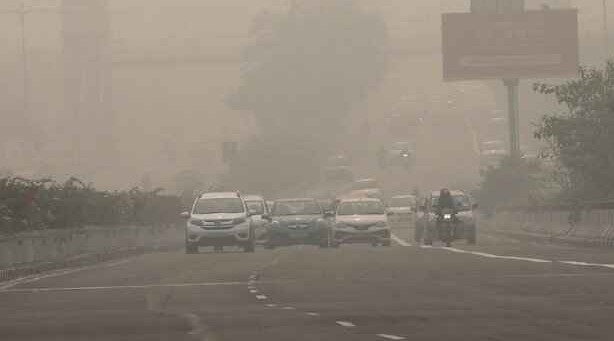Beijing shuts roads, playgrounds amid heavy smog
Schools in the capital, which will host the Winter Olympics in February, were ordered to stop physical education classes and outdoor activities

Motorways and school playgrounds in Beijing were closed today due to heavy pollution, as China ramps up coal production and faces scrutiny of its environmental record at make-or-break international climate talks.
World leaders have gathered in Scotland this week for COP26 negotiations billed as one of the last chances to avert catastrophic climate change.
However, Chinese President Xi Jinping made a written address instead of attending in person.
China is the world's largest emitter of the greenhouse gases responsible for climate change.
It has ramped up coal output after supply chains in recent months were disrupted by an energy crunch owing to strict emissions targets and record prices for the fossil fuel.
A thick haze of smog blanketed swathes of northern China this morning, with visibility in some areas reduced to less than 200 metres, according to the country's weather forecaster.
Schools in the capital, which will host the Winter Olympics in February, were ordered to stop physical education classes and outdoor activities.
Stretches of highways to major cities including Shanghai, Tianjin and Harbin were closed due to poor visibility.
Pollutants detected by a monitoring station at the US embassy in Beijing reached levels defined as "very unhealthy" for the general population.
Levels of small particulate matter, or PM 2.5, which penetrate deep into the lungs and cause respiratory illnesses, hovered around 230, far above the WHO recommended limit of 15.
Authorities in Beijing blamed the pollution on a combination of "unfavourable weather conditions and regional pollution spread" and said the smog was likely to persist until at least tomorrow evening.
But the "root cause of smog in north China is fossil fuel burning," said Greenpeace East Asia climate and energy manager Danqing Li.
China generates about 60% of its energy from burning coal.
It has increased coal output to ease an energy shortage that had forced factories to close in recent months.
Average daily coal production in the middle of October was 1.1 million tonnes higher than the end of September, according to a Sunday statement by the country's top economic planning body.
National coal stores hit 112 million tonnes earlier this week, a "normal level for the average year", the agency said on Thursday.
Like many places in rapidly industrialising China, Beijing is no stranger to air pollution. However, severe smog episodes have become less frequent in recent years as authorities have increasingly prioritised environmental protection.
"The air in the last few years has been excellent, with very little smoggy weather," Beijing resident Song Ximeng told AFP.
"This only happens very rarely."
In his COP26 statement, Mr Xi urged developed countries to provide more climate change support to developing nations, but stopped short of making any significant new commitments from China.
China has already pledged to bring emissions of planet-heating carbon dioxide to a peak by 2030 and reduce them to net zero by 2060.
It hit back on Wednesday at criticism by Joe Biden, saying "actions speak louder than words" after the US president accused Beijing of not showing leadership to combat climate change.
Delhi wakes to post-Diwali smog
Meanwhile, residents of New Delhi woke up under a blanket of toxic smog and breathed in the most dangerously polluted air of the year so far.
It came the morning after Diwali, the Hindu festival of lights, where revellers, as usual, defied a fireworks ban.
New Delhi has the worst air quality of all world capitals, but even by its standards today's reading was extra bad, as people paid the price for celebrating India's biggest festival in the noisiest, and most smoky way.
The Air Quality Index (AQI) surged to 451 on a scale of 500 - the maximum recorded this year - indicating "severe" conditions that affect healthy people and seriously impacts those with existing diseases, according to the federal pollution control board's guidance.
The AQI measures the concentration of poisonous particulate matter PM2.5 in a cubic metre of air.
In Delhi, a city of nearly 20 million people, the PM2.5 reading averaged 706mg, whereas the World Health Organization deems anything above an annual average of 5mg as unsafe.
Airborne PM2.5 can cause cardiovascular and respiratory diseases such as lung cancer. And, in India, toxic air kills more than a million people annually.
"The firecracker ban didn't seem to be successful in Delhi, which led to hazardous pollution levels adding on top of existing perennial sources," Sunil Dahiya, Analyst, Centre for Research on Energy and Clean Air (CREA) said.
